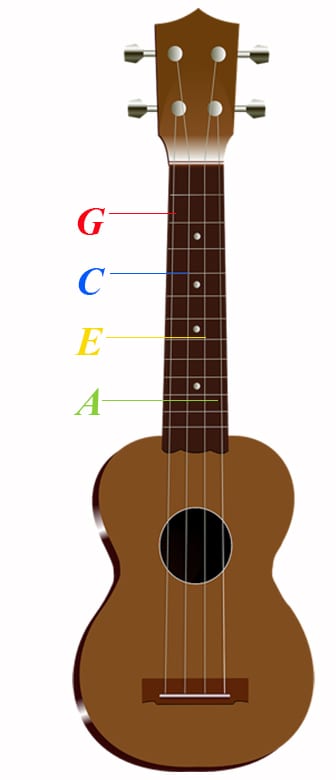In order to play any stringed instrument (like a ukulele), you have to learn how to strum! Not quite sure which technique to use? In this article and video, Winston Salem, NC teacher Willy M. shows you how to strum a ukulele…
Today we’re going to take a closer look at how to strum a ukulele. I have also included a video to show you the proper technique. Before we get into strumming specifics, let’s review how to hold a ukulele and how to tune a ukulele.
Whether you’re a beginner or an experienced player, learning how to strum a ukulele is an essential part of playing this instrument. In this blog post, we’ll provide some tips on how to strum a ukulele and teach you the basic strumming patterns that will help you get started.
So whether you’re just starting out or looking to improve your skills, read on for some helpful advice on strumming a ukulele!
What Finger Do You Strum a Uke With?
Before we dive into the nitty gritty of ukulele strumming, you should know that the ukulele is meant to be strummed with the index finger. Other tips for strumming a ukulele are:
- The energy in the strum should come from your wrist
- Keep your pointer finger relaxed
- Tune the ukulele before you start playing
- Use a pick (or not!)
For the best advice on how to strum a ukulele, it’s a good idea to get lessons from a pro. Consider signing up for ukulele lessons and you’ll learn everything you need to know about strumming. Check out the example video below:
https://www.youtube.com/watch?v=cawOj-lPJaU
How Do You Strum a Ukulele Smoothly?
Learning how to strum a ukulele sounds simple enough, but if you want to know how to strum a ukulele correctly, without a harsh sound, then you should heed these tips.
First, make sure most of the energy is coming from your wrist. YOur pointer finger shouldn’t be rigid and locked, nor should it be totally limp. Keep the finger bent and relaxed.
Attack the strings cleanly. Make sure you use the right parts of your fingers to strum the strings – don’t allow the strings to touch anything past the nail on your finger or you’ll create a jerky-sounding strumming.
Finally, if you want more volume, just tilt your finger so that there’s a little bit of nail involved. Be careful doing this so it doesn’t sound sharp, as mentioned earlier, or consider just adding your thumb instead to be safe.
How to Tune a Ukulele
Even if your strumming technique is perfect, you’re not going to get the sound you want if your ukulele is out of tune, so it’s important to learn how to tune a ukulele. Standard tuning is the most common way to tune a ukulele, and the tuning you should learn as a beginner. When you tune your ukulele in standard tuning, you tune your strings to G, C, E, and A.
Chromatic Tuner Tips
In the video, I show you how to tune your ukulele with a chromatic tuner. Chromatic tuners usually have three lights, or a series of lights, red on both sides, and green in the middle. These types of tuners are better than the ones that only have one light.
Many beginning musicians think that all tuners are the same, but some of them are slightly out of caliber. So if you use one tuner and your friend uses another, you might be slightly out of tune with each other. In order to perform with other people, use the same tuner. It will save you some headaches in the long run.
Sometimes, it helps to start in the middle and tune out toward the outside of your ukulele. Instead of just tuning G C E A, you might want to start with C and E, and then tune the G and A, it can make tuning easier if your uke is pretty far out of tune.
You can purchase a tuner at a music store or you can download a tuning app for your smartphone.
If you don’t have a chromatic tuner, you can still tune to a keyboard, a pitch pipe, a harmonica, or even tune the ukulele to itself. If you don’t have a chromatic tuner, here’s how to tune a ukulele using these other methods.
One thing to keep in mind as you tune your ukulele: nylon strings often stretch, and the wood expands and contracts depending on humidity. So if your uke goes out of tune, simply keep working at tuning it until it settles in.
Sometimes, it can take a while to fine-tune your ukulele, but keep at it. The more you practice, the better you will be at tuning your ukulele.
How to Hold a Ukulele
One of the most common questions asked by beginning ukulele players is how to hold and strum a ukulele properly.
Technically, there’s nothing very special about holding the ukulele; the key is to make sure you’re comfortable. You don’t want to strain your wrist or cause any undue tension. If you get in the habit of playing with tension, it can cause all sorts of medical problems, in the long run; so try to stay relaxed.
Cradle the body of your ukulele with your picking hand, and hold the neck gently with your fretting hand. Your elbow should be at a 90-degree angle, more or less, and your wrist should be relatively straight.
How to Strum a Ukulele
Here’s a guide on how to strum a ukulele for beginners.
How to Strum a Ukulele With Fingers
There are several different ukulele strumming patterns that you can try, but essentially, there are up strums and down strums. When you’re just learning to play, the easiest way to strum your ukulele is to simply strum up and down with your fingers.
You can use your fingernails or the pads of your fingers to strum the ukulele strings. See which method feels more comfortable, and which one produces the best sound. In the video, you will learn about the different sounds you get from using your fingernails, the pads of your fingers, and your thumb.
The basic up-down strum can be done rhythmically with the beat of the music to produce just about any strumming effect you can imagine. You can strum fast or slow, depending on the rhythm of the song, and this simple pattern gives you time to change chords with the changes in the song. It may not seem glamorous, but the up-down strum works wonders.
What Finger Do You Strum a Ukulele With?
For the most part, you will strum the ukulele with your index finger. If you want to create a rounder sound, you can use your thumb.
However, using your index finger is appropriate for most chords.
Is it Okay to Strum a Ukulele With Your Thumb?
Yes. You can use any digit you like to strum your ukulele. However, you need to be careful that the strings don’t hit your fingernail, or this can cause a sharp, off-key sound.
How to Strum a Ukulele With a Pick
You can also strum a ukulele with a flat pick. You can do the up-down strum with any type of pick, from a regular guitar pick to a felt ukulele pick.
When you hold the pick in your hand, hold it firmly, but not so tight that it gives you tension or pain in your hand. Hold your pick between your thumb and first finger. When you use a pick, you can pick one string at a time, or you can strum up and down.
When you strum a ukulele with a pick, you don’t have to worry about what to do with all of your fingers, you can simply strum up and down.
How to Strum a Ukulele Without a Pick
You don’t have to use a pick when you’re playing the ukulele. Although it can give it a different sound, playing without a pick is fine, too.
Ukuleles have nylon strings, so if you do use a pick, you won’t need a heavy one – and if you don’t, you shouldn’t find that the strings hurt your fingers.
Regardless of whether you use a pick or not, make sure you are strumming with the energy coming from your wrist instead of the fingers to make sure you get the best quality sound.
How to Strum a Ukulele
Follow along with this video to learn how to strum a ukulele.
How to Strum a Ukulele Without Hurting Your Fingers
The best way to strum a ukulele without hurting your fingers is to make sure you are using your dominant arm to strum.
Make sure you’re using the right strumming pattern (more on this below!) and be sure you’re strumming in the right pattern.
Don’t tense up when you’re strumming. Again, the wrist and forearm should not be doing anything besides rotating. Stay relaxed and do hand and finger exercises. This will help your hands develop the flexibility they need for great (and pain-free) ukulele playing.
Practice makes perfect – and the more you practice, the quicker calluses will develop on your fingers. Once that happens, you shouldn’t have any more pain.
How to Read a Strumming Pattern Ukulele
Now that you know how to properly strum a ukulele, the only thing left to figure out is how to read a strumming pattern.
Here’s a helpful guide to introduce you to the most popular ukulele strumming patterns, as well as some tips you can follow as you are learning how to read them.
How Do You Practice Strumming on the Ukulele?
Make strumming practice a daily part of your ukulele practice routine. Use the tips we’ve given you above and work your way through as many different strumming patterns as you can. This is the best way to become a skilled ukulele player!
Ukuleles are a great instrument for all skill levels. If you’re just starting out, remember to keep your hand relaxed and use the tips we shared to help you find chords. As you continue practicing, experiment with different strumming patterns and try new songs. With a little bit of practice, you’ll be playing like a pro in no time!
Now you know some simple tricks to get started playing your ukulele. I hope you enjoyed the video, and if you want to learn more about alternate tunings, you can check out some of my other videos. Until next time, keep on practicing!
Which ukulele strumming method do you prefer? Let us know in the comments below!
 Post Author: Willy M.
Post Author: Willy M.Willy M. teaches guitar, ukulele, and mandolin lessons in Winston Salem, NC. He’s the author of the Dead Man’s Tuning series of mandolin songbooks, and is a former member of the American Federation of Musicians. Willy has been teaching for 20 years, and his students have ranged in age from young children to folks in their 80s. Learn more about Willy here!
Image courtesy Debby
Maile Proctor


